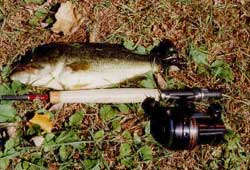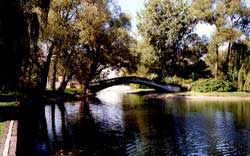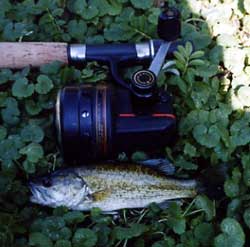| MARK WINTLE |
| Mark Wintle, an angler for thirty-five years, is on a quest to discover and bring to you the magic of fishing. Previously heavily involved with match fishing he now fishes for the sheer fun of it. With an open and enquiring mind, each week Mark will bring to you articles on fishing different rivers, different methods and what makes rivers, and occasionally stillwaters, tick. Add to this a mixed bag of articles on catching big fish, tackle design, angling politics and a few surprises. Are you stuck in a rut fishing the same swim every week? Do you dare to try something different and see a whole new world of angling open up? Yes? Then read Mark Wintle’s regular weekly column. |
TO CATCH A CANADIAN SMALL MOUTH BLACK BASS
Here in the UK we have many different types of freshwater fish, but despite many attempts to establish it, the black bass has never been able to really thrive here. There are, in fact, two varieties – small mouth and large mouth. Both are held in high regard in both the USA and Canada, their original home. Their willingness to take a variety of both artificial and natural baits, and slugging fighting ability, make them a popular quarry.
A recent short break in Toronto gave me a chance to catch a small mouth bass. As this was intended to be a holiday rather than a fishing trip, I knew that I would only really get a single day. Throughout Ontario, there are a phenomenal number of lakes and rivers that contain bass. But without a car I was restricted to trying my luck on the Toronto Islands where a series of inlets from Lake Ontario separate the different islands. These shallow and weedy canal-like waters are hardly the best bass water in the province but for me their convenience and the chance of some light-hearted sport made up for this. At one time, the Great Lakes had major pollution problems but gradually a cleanup has reaped benefits, and today there are a number of species in abundance. Get a license and travel light Despite the predicted landfall of Hurricane Isobel on the Friday, most of the week was predicted to be warm and sunny, so it was a case of picking a day for the trip. I found a flyfishing store just around the block from the hotel and obtained a non-residents fishing license. The tackle I took over bordered on the minimalist. A travel fly rod rated 5/6, a closed face reel, some small Mepps bar spoons and forceps. I had enough previous knowledge of the Islands to know that this should be sufficient to have some fun. The banks are low so landing a fish shouldn’t prove too difficult. I’m only a novice fly caster so true fly-fishing for the bass would put me out of my depth. I reckoned the small Mepps were sufficiently effective to provoke some takes.
To get to the Islands I caught the ferry from the dock on the waterfront in Toronto. Not far from the dock in the islands, there is a small humpbacked bridge over one of the inlets. Peering into two feet of water, I spotted two good bass of two to three pounds. The bottom was sandy here with little weed, though there were large areas of soft weed away from the bridge. I tackled up the rod well away from the water’s edge with a no 1 Mepps. A tiddler I cast to the edge of the weed, trying to anticipate where the bass might be lying. But after ten minutes it was clear that these two fish had gone, scared by my attempts to catch them. On the other side of the bridge, there is a large shallow bay. Here and there, I spotted a small bass, fish of just seven or eight inches. One of these would break my duck before attempting to snare bigger game. Takes were not long in coming but these aggressive little fish were not big enough to engulf the spinner. I endured a series of knocks before hooking a bass of seven inches. It was a start but hardly big enough to put a bend in the rod. I had another look from the bridge but the two big ones hadn’t returned. I walked down to the next bridge. Here, lying in a hole in the weed was a bass of about a pound. There was only six inches of water on top of the weed. Although I provoked a reaction, it was not long before I spooked the bass. A carp nosed its way through the weed under the bridge. At about fifteen pounds, many anglers over there still regard it as a trash fish but attitudes are very slowly changing. The Canadian angling authorities are even encouraging anglers to give fishing for carp a go.
Sport seemed limited in this bay so I moved on to yet another stretch of water where a rowing course ended at another humpbacked bridge. The water looked deeper here, at least four feet or more. Although there were again plenty of weedbeds, there was also plenty of open water in between to work the spinner. Clambering down to the side of the bridge, I looked under it. By the side of a weed bed I could see two bass of about a pound, just eight feet away. I overcast beyond the bass. As I wound in the spinner – wallop. Now the fun started. Bass are pugnacious fighters, grudging, never yielding an inch. This one tried tail walking, and made repeated attempts to get into a weed bed. After a frantic fight, I was able to grab him. Just a pound, but big enough to fight back. As the afternoon wore on, I got more small bass up to a pound, finishing with nine. Several times, three or four little bass of seven or eight inches chased the spoon, and hits that failed to connect were commonplace. Before catching the boat back to Toronto I returned to the first inlet where I’d seen the two bigger bass. They’d returned but were wise to my antics in trying to catch them. Maybe next time?
NEXT WEEK IN WINTLE’S WORLD: ‘Home Waters’ |

















